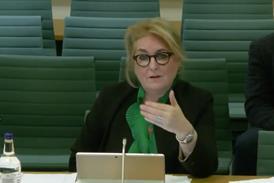The emerging revelations about sex abuse in football suggest mistakes were made. How can we ensure they are not repeated?
Historic child abuse appears to be a never-ending nightmare in today’s society. The latest visitation comes from the world of football. The sport has long been tarnished by tales of bribery and corruption at national and international level but the child abuse scandal is much closer to home and it is deeply personal. This time, it is football’s children who have been betrayed. There is a wellspring of suffering that is now flowing out of the beautiful game. At present, we have only heard a fraction of the accounts of abuse that going to be told as criminal prosecutions and inquiries get under way.
Greg Clarke, the chairman of the Football Association, has described clubs as ‘sleepwalking’ throughout the 1980s and 90s. To be fair, it is important to understand the setting in which this alleged abuse took place.
By the 1970s, it was the increasing practice of professional football clubs to take talented youngsters from all over the country and put them through their own in-house training programmes. This meant taking children out of their homes and accommodating them near to the club or in local training centres. That placement of a child in a strange town or city, coupled with the absolute power that football coaches wielded over their future, created numerous opportunities for abuse.
It would be a mistake to think that child protection was an alien concept in the 70s and 80s. By the time of the Children Act 1989, the authorities had long regulated the care of children. An early example would be the Nurseries and Child-Minders Regulation Act 1948, which required local health authorities to keep registers of premises where children were being looked after for short periods of time. Children’s homes and foster placements, both in the private and public sector were covered by a long list of statutes and regulations.
In 1974, local authorities set up Area Child Protection Committees and so conceivably these committees might have become aware of a child protection issue in a football club. There were also general laws to protect children from exploitation, which remain in place today. The Children and Young Persons Act 1933 placed restrictions on the employment of children under 14 or at school. If children under 18 were taken abroad to play for a team, then the trip could only be undertaken under licence.
There was also a rudimentary system of criminal records checks. From the 1 February 1964, the police would notify social services of the existence of a convicted sexual abuser in their area. The Criminal Records Office (the forerunner to the Criminal Records Bureau) was used by childcare organisations from at least 1965. Prison authorities would notify local authority social services departments of the release of men convicted of incest, and in 1975 these arrangements were extended to the release of persons convicted of offences against children in the home.
From 1982, social services and certain other statutory agencies (such as the probation service) had the ability to check with the police for a person’s criminal record. In the same year, police checks for childminders were instituted and later widened to other categories of persons working with children. The police also added the convictions of those known to be or having been involved in teaching or the care of children to List 99, which was maintained by the Department for Education.
Moreover, guidance issued by the government asked local authorities to notify the Consultancy Service of persons who might resign or be dismissed but were considered unsuitable to work with children. This guidance did not cover private homes or permit or expect local authorities to make such checks. Local authorities and voluntary organisations were also able to check with another list, the DHSS Consultancy Index. This provided information on a register of persons compiled from police, local authority and voluntary organisation reports and List 99.
List 99 was given recognition by section 218(6) of the Education Reform Act 1988. Under this act, regulations were introduced in September 1989 for state schools which prohibited or restricted the employment of teachers, who were deemed guilty of ‘misconduct’. Those same regulations required a school which found ‘misconduct’ to report the matter to the authorities. They could not simply pass the teacher on to another school quietly, at least not legally. The idea of ‘misconduct’ - something short of a criminal conviction - being sufficient to bar a person from caring for children remains a key concept under the present Safeguarding Vulnerable Groups Act 2006.
A football club in the 70s and 80s would probably not have undertaken criminal record checks on the coaches that it employed to look after children, or made checks on List 99 and the Consultancy Index. Of course, such a check would not have identified an abuser without a conviction or a record of misconduct. Moreover, the football club would not have been under any statutory duty to notify the authorities of ‘misconduct’ by one of its employees. Football clubs in common with other organisations with the care of children, operated outside the system described above, whereas nowadays they are firmly inside the system.
Of course, the vetting of employees’ records and lists, is never a failsafe procedure if the abuser does not appear on the system. A robust child protection procedure gives another layer of protection, but it only works if it is accompanied by a keen awareness of the risk.
During the 70s and 80s, most social workers knew of the existence of the physical and sexual abuse and the neglect of children. The abuse of a child in a care setting was known to be possible, but it was considered rare. A carer might be found to be harsher and less child centred than one might expect today, but provided that the reported behaviour was occasional, the chances were that this would be interpreted as an example of patience wearing out. Social workers also tended to be sceptical of a child making a disclosure.
On the other hand, most social workers and many carers knew that they should remain open to the possibility of a child disclosing abuse, in stages rather than all at once. The protection of children from sexual abuse in the seventies and the eighties was not an alien concept. Court records and newspaper reports from those decades show that the sexual abuse of children in and out of institutions was a crime that was routinely prosecuted by the courts.
The main criminal statute on sexual offences was the Sexual Offences Act 1956, but this had been bolstered and extended by a series of acts including the Protection of Children Act 1978, which deals with child pornography. A seminal guide for social workers published in 1988, Protecting Children begins with the words: ‘The 1980s have seen four major child abuse inquiries which have been the focus of much public and professional concern.’
This guidance makes reference to another important document, Working Together, which was published in the same year by the Department for Health and Social Security. By the late 80s, the abuse of children in both the family home (the Cleveland Report) and children’s homes (Frank Beck in Leicestershire children’s homes) was being widely reported. Following the Children Act 1989, the child protection system was further expanded. The Sex Offenders Act 1997 created a national database of offenders and the Police Act 1997 set up the Criminal Records Bureau. Increasingly it was recognised that there were still huge gaps to be filled.
In 1997, a report entitled People Like Us by Sir William Utting examined the range of safeguards available for children living away from home. This report was commissioned in the wake of allegations of child abuse in children’s homes and foster care in North Wales. It was published in 1997 with 20 principal recommendations for improving policy and practice, most of which were accepted by the government.
The government response was enacted in the Protection of Children Act 1999. This placed List 99 and the Consultancy Index on a statutory footing, and created a framework for identifying people unsuitable to work with children. It also brought together the various databases and compelled employers to access a single point for checking the names of people they proposed to employ in a post involving the care of children. Also in 1999, the Home Office also issued guidelines in relation to sex offenders entitled Guidance on the disclosure of information about sex offenders who may present a risk to children and vulnerable adults. The Care Standards Act 2000 extended the statutory protection scheme to vulnerable adults.
The police were also given wide-ranging powers over convicted sex offenders beginning with the Criminal Justice and Courts Services Act 2000. From 2012, the police were allowed in certain circumstances to make a disclosure about a sex offender to a person under the Child Sex Offender Disclosure Scheme. This allows parents of children and other interested parties to request details of abuser in their vicinity.
Our modern system of child (and adult) protection rests in the Safeguarding Vulnerable Groups Act 2006. Following the murders of Jessica Chapman and Holly Wells in 20002 by Ian Huntley, a school caretaker, the government commissioned an inquiry by Sir Michael Bichard, which identified systemic failures in vetting and barring systems.
These included inconsistent decisions being made by employers on the basis of Criminal Records Bureau information, disclosure information going out of date and inconsistencies between a variety of databases that stored on abusers and persons who were adjudged to be unsuitable to look after children. There was also a plethora of statutes that had emerged over the years to try and stop abusers from gaining access to children. What the 2006 act did was consolidate these arrangements, and set up a comprehensive system for vetting and barring people who worked with children and young persons.
The Football Association can say with some justification that our present system of child protection is very far from what was available to club in the 80s and 90s. As pointed out above, it takes more than a vetting system to stop abuse. Childcare organisations have to sign up to the concept of risk, and there is evidence suggesting that football has not done that.
Despite the prosecution of a number of football coaches in the 90s, there was no investigation by the clubs into what might have been going on with their children and during their watch.
The rumours of abuse and the reports of inappropriate behaviour towards children appear to have been ignored. When these rumours and reports could no longer be ignored, the coach in question appears to have moved on quietly without any kind of prosecution or investigation taking place. These are the classic mistakes made by schools, the church and children’s homes, examined in appalling detail by inquiry after inquiry. Football’s experience shows that the lessons are not always learned.
Here then, is one basic lesson. Things will go wrong when an organisation puts its own needs above those of the children for whom it cares. In football, that imbalance is amply demonstrated by the vast sums spent on adult players as opposed to those spent on basic child protection. If anyone thinks that such things could not happen today, they should speak to someone who is involved in modern child protection.
We are beginning to learn what happened to child protection in football, but we need to know what is happening now.
Malcolm Johnson, BL Claims Solicitor




























1 Reader's comment